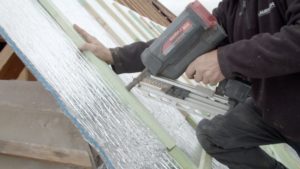Choosing the Thinnest Insulation Possible for Your Next Project

When it comes to insulation, many people think thicker is always better – but that isn’t always an option. In any kind of project, you may find yourself in need of insulation that is both thin and effective. So, how do you select the right one? Let Aluthermo Quattro Insulation walk you through the best way to keep your insulation thin without sacrificing quality.
Why Choose Thin Insulation?
Thinner insulation may be a necessity in some projects, but it doesn’t have to mean you sacrifice effectiveness. In fact, there can be many benefits to thinner insulation for any building.
Thin insulation is particularly beneficial in areas where maximizing space is crucial, such as in attics with limited headroom, narrow wall cavities, or small apartments. In some cases, the thinner materials will also be easier to install and take less time, making them a good choice for tight timelines and DIY projects.
Older buildings in particular can call for thin insulation, when the structure itself can’t accommodate thick products without significant alterations. Thinner substitutes can allow for easier installation that improves the building without starting over.
Not only can this save costs on framing and structural changes, but it can actually offer improved energy efficiency thanks to advances in insulation technology.
Building codes reference to so called R-values. The required R-value indicates the insulation performance of a wall-assembly. This is often confused with the R-value of an insulation material. The R-value of an insulation material is an indication about the capacity of that material to ABSORB heat. Reflective insulation materials do NOT absorb heat. They reflect heat, just as an umbrella reflects rain. Nevertheless, reflective insulation can contribute substantially to the R-value of a wall-assembly by blocking the transfer of heat.
Types of Thin Insulation
There are numerous kinds of thin insulation available, depending on the type of project you are doing.
Aerogel Insulation
Aerogel is one of the most advanced and effective insulation materials available. Known for its extremely low thermal conductivity, aerogel provides excellent insulation in a very thin profile. It is ideal for applications where space is limited but high thermal performance is required, such as in walls, roofs, and floors.
Reflective Foil Insulation
Reflective foil insulation consists of one or more layers of reflective material, usually aluminum, sandwiching a layer of foam or plastic. This type of insulation works by reflecting radiant heat away from the building, making it highly effective in hot climates. It is very thin and lightweight, making it easy to install in walls, roofs, and crawl spaces.
Vacuum Insulation Panels (VIPs)
VIPs are another high-performance option for thin insulation. These panels are made by encasing a core material, typically fumed silica, in a vacuum-sealed barrier. The vacuum reduces heat transfer, providing excellent insulation with a minimal thickness. VIPs are often used in specialized applications, such as refrigeration units, high-performance buildings, and space-constrained areas.
Spray Foam Insulation
While traditional spray foam can vary in thickness, there are low-profile options available that expand to fill small gaps and crevices effectively. Spray foam provides both thermal insulation and air sealing, making it a versatile choice for a variety of applications, including walls, attics, and crawl spaces.
Thin Fiberglass and Mineral Wool Batts
Manufacturers have developed thinner versions of traditional fiberglass and mineral wool batts that still offer good thermal performance. These products can be particularly useful in retrofitting projects where space is limited but improved insulation is needed.
Choosing the Right Thin Insulation
When selecting thin insulation, it’s essential to consider several factors to ensure you get the best performance and value for your project. Some things to keep in mind may include:
- R-Value: When selecting thin insulation, it’s essential to consider the R-value to ensure you’re getting the thermal performance you need. Compare the R-values of different thin insulation materials to find the best fit for your project’s requirements.
- Moisture Resistance: Depending on the location of your insulation, moisture resistance might be a critical factor. Some thin insulation materials, such as spray foam and certain types of reflective foil, offer excellent moisture resistance, which can prevent mold and mildew growth.
- Fire Resistance: Check the fire resistance ratings of thin insulation materials, especially if you’re installing them in areas prone to high temperatures or near potential fire hazards.
- Installation Method: Consider how the insulation will be installed and whether it requires professional installation or can be done as a DIY project. Some thin insulation materials, like spray foam, may need specialized equipment and expertise, while others, like reflective foil, are easier to install with basic tools.
- Cost: While thin insulation can be cost-effective in many scenarios, it’s important to balance initial costs with long-term savings. Evaluate the overall cost, including materials, labor, and potential energy savings, to make an informed decision.
Aluthermo Quattro Insulation: Through Thick and Thin
Despite popular belief, choosing the thinnest insulation possible for your project can be the best option in many cases, with some benefits of its own.
At Aluthermo Quattro Insulation, we specialize in providing top-quality insulation solutions tailored to your unique requirements. Whether you’re working on a retrofit, new construction, or renovation project, our team of experts can help you select the best thin insulation materials to achieve your goals. Get in touch with us today.


